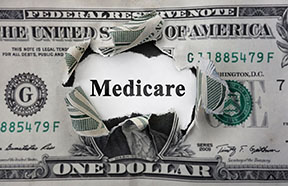

The State of Medicare: 2018 and 2026
Medicare, like the federal government's Social Security program, is on track to eventually run out of funds to pay the entire amount of claims made.
Medicare's trustees reported the trust fund for Medicare Part A may "run dry" by 2026. If this happens, the program would only be able to pay 91 percent of promised benefits.
Medicare is the federal health insurance program for people 65 or older; certain young people with disabilities; and people with End-Stage Renal Disease. Different Medicare programs cover specific services. More than 44 million Americans currently receive Medicare benefits. Part A covers inpatient hospital stays, care in a skilled nursing facility, hospice care and some home health care.
Medicare Part B, which helps recipients pay for doctor's bills and outpatient expenses; and Part D, which offers prescription drug coverage, will be financed in full indefinitely. The two programs are treated differently because federal law requires both programs to be financed. Experts expect the costs for the programs to grow from 2.1 percent of gross domestic product in 2017 to 3.6 percent in 2037.
Medicare Trustees originally predicted that the Part A trust fund would go broke by 2017, but a robust economy stalled the decline. They now believe there will be a decline in revenue because of recent tax cuts, which they believe will reduce the taxes people pay for Social Security and Medicare benefits.
The federal government is mandated to set aside funds to cover future costs and to invest the funds in special government securities, which collect interest. Unfortunately, the government has continually borrowed from that fund.
The problem of insufficient funding does not have an easy solution. The millions of baby boomers who soon will need care, and the unpredictability of health care costs, complicate the situation.
President Donald Trump has pledged to not cut Medicare funding. House Speaker Paul Ryan (R-Wis.) has pledged that an overhaul of Medicare will be a priority this year, although there have been no specific plans announced. Democrats are leaning more toward implementing tax increases to keep the two programs solvent.
Your Options Today
The sign up period to receive benefits begins three months before you turn 65 and ends three months after the month you turn 65. If you don't enroll when you become eligible, you may have to pay a Part B late enrollment penalty. However, if you are still employed and receive employer-sponsored health insurance, you may be able to delay Parts A and B without having to pay a penalty when you enroll later.
You can choose from three different types of Medicare coverage — Original Medicare (Part A and Part B) or a Medicare Advantage Plan (Part C). You also can pay for additional coverage, such as Medicare prescription drug coverage or Medicare Supplement Insurance (Medigap).
Here’s what each type covers.
Medicare Part A (Hospital Insurance)
Part A covers inpatient hospital stays, care in a skilled nursing facility, hospice care, and some home health care. You can receive Part A coverage premium free if you are 65 years or older and you or your spouse worked and paid Medicare taxes for at least 10 years.
Medicare Part B (Medical Insurance)
Part B covers certain doctors’ services, outpatient care, medical supplies, and preventive services. In 2018, the standard Part B premium amount is $134 (or higher depending on your income).
Medicare Part C (Medicare Advantage Plans)
Part C is a Medicare health plan offered by a private company which contracts with Medicare. Medicare Advantage Plans provide your Part A and Part B benefits. Consult with your broker, because costs vary by plan.
Medicare Part D (prescription drug coverage)
Part D adds prescription drug coverage. Again, consult with your broker, because costs vary by plan.
Medicare can seem complicated and intimidating when you first get started. Give us a call and we’ll help you understand your options.
[return to top]
Getting Ahead of the Curve: Planning Now for Social Security Deficiencies
The State of Medicare: 2018 and 2026
The information presented and conclusions within are based upon our best judgment and analysis. It is not guaranteed information and does not necessarily reflect all available data. Web addresses are current at time of publication but subject to change. SmartsPro Marketing and The Insurance 411 do not engage in the solicitation, sale or management of securities or investments, nor does it make any recommendations on securities or investments. This material may not be quoted or reproduced in any form without publisher’s permission. All rights reserved. ©2018 The Insurance 411. www.theinsurance411.com Tel. 877-762-7877.